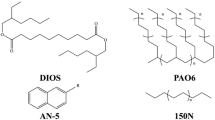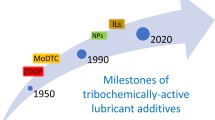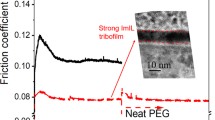Abstract
The surface and tribological chemistry of 2-propanol and borate esters, isopropoxy tetramethyl dioxaborolane (ITDB), and tetramethyl dioxaborolane (TDB) as gas-phase lubricants for copper surfaces are compared by measuring the friction coefficient and contact resistance in an ultrahigh vacuum tribometer. 2-propanol reacts on copper below room temperature to desorb primarily acetone and causes no friction reduction when used as a gas-phase lubricant. TDB decomposes to deposit BOx species on the surface and produces an initial decrease in friction coefficient that is not sustained. ITDB, which reacts at room temperature to form a tetramethyl dioxaborolide species on the surface, results in an immediate and sustained decrease in friction coefficient when used as a gas-phase lubricant for copper. This indicates that the surface chemistry of the borate esters can be correlated with their tribological properties and illustrates the effect of replacing a hydrogen atom in TDB with a 2-propoxy group in ITDB on both the surface and tribological chemistry. Analysis of the species formed in the wear track after lubrication with ITDB reveals the presence of graphitic or diamond-like carbon and oxygen, and these elements are also found in the subsurface region of the sample. Rubbing the sample in vacuo after reacting with ITDB shows the removal of a boundary film where the coefficient remains constant and the subsequent removal of the subsurface layer in which the contact resistance rises to its original value.






Similar content being viewed by others
References
Blunt, T.J., Kotvis, P.V., Tysoe, W.T.: Determination of interfacial temperatures under extreme pressure conditions. Tribol. Lett. 2(3), 221–230 (1996). doi:10.1007/bf00173128
Furlong, O.J., Miller, B.P., Kotvis, P., Tysoe, W.T.: Low-temperature, shear-induced tribofilm formation from dimethyl disulfide on copper. ACS Appl Mater Interfaces 3(3), 795–800 (2011). doi:10.1021/am101149p
Furlong, O., Miller, B., Tysoe, W.T.: Shear-induced boundary film formation from dialkyl sulfides on copper. Wear 274–275, 183–187 (2012). doi:10.1016/j.wear.2011.08.022
Furlong, O., Miller, B., Tysoe, W.: Shear-induced surface-to-bulk transport at room temperature in a sliding metal–metal interface. Tribol. Lett. 41(1), 257–261 (2011). doi:10.1007/s11249-010-9711-4
Miller, B., Furlong, O., Tysoe, W.T.: The kinetics of shear-induced boundary film formation from dimethyl disulfide on copper. Tribol. Lett. (2012). doi:10.1007/s11249-012-0040-7
Washburn Robert, M., Levens, E., Albright Charles, F., Billig Franklin, A.: Preparation, properties, and uses of borate esters. In: Metal-Organic Compounds, Advances in Chemistry vol. 23, pp. 129–157. American Chemical Society, New Orleans (1959)
Adams, J.H.: Borate—a new generation EP gear lubricant. Lubr. Eng. 33(5), 6 (1977)
Kreuz, K.L., Fein, R.S., Dundy, M.: EP films from borate lubricants. ASLE Trans 10(1), 67–76 (1967). doi:10.1080/05698196708972166
Philippon, D., De Barros-Bouchet, M.I., Lerasle, O., Le Mogne, T., Martin, J.M.: Experimental simulation of tribochemical reactions between borates esters and steel surface. Tribol. Lett. 41(1), 73–82 (2011). doi:10.1007/s11249-010-9685-2
Kimura, Y., Wakabayashi, T., Okada, K., Wada, T., Nishikawa, H.: Boron nitride as a lubricant additive. Wear 232(2), 199–206 (1999). doi:10.1016/s0043-1648(99)00146-5
Goto, M., Kasahara, A., Tosa, M., Yoshihara, K.: Control of frictional force on coating films of boron nitride-copper complex in ultra high vacuum. Thin Solid Films 405(1), 300–303 (2002). doi:10.1016/s0040-6090(01)01727-8
Erdemir, A., Bindal, C., Fenske, G.R.: Formation of ultralow friction surface films on boron carbide. Appl. Phys. Lett. 68(12), 1637–1639 (1996)
Hu, Z.S., Yie, Y., Wang, L.G., Chen, G.X., Dong, J.X.: Synthesis and tribological properties of ferrous octoxyborate as antiwear and friction-reducing additive of lubricating oil. Tribol. Lett. 8(1), 45–50 (2000). doi:10.1023/a:1019154327736
Zheng, Z., Shen, G., Wan, Y., Cao, L., Xu, X., Yue, Q., Sun, T.: Synthesis, hydrolytic stability and tribological properties of novel borate esters containing nitrogen as lubricant additives. Wear 222(2), 135–144 (1998). doi:10.1016/s0043-1648(98)00323-8
Miller, B.P., Furlong, O.J., Tysoe, W.T.: Surface chemistry of isopropoxy tetramethyl dioxaborolane on Cu(111). Langmuir 28(15), 6322–6327 (2012). doi:10.1021/la300276q
Davis, J.L., Barteau, M.A.: Decarbonylation and decomposition pathways of alcohol’s on Pd(111). Surf. Sci. 187(2–3), 387–406 (1987). doi:10.1016/s0039-6028(87)80064-x
Sexton, B.A., Rendulic, K.D., Huges, A.E.: Decomposition pathways of C1–C4 alcohols adsorbed on platinum (111). Surf. Sci. 121(1), 181–198 (1982). doi:10.1016/0039-6028(82)90245-x
Gleason, N., Guevremont, J., Zaera, F.: Thermal chemistry of 2-propanol and 2-propyl iodide on clean and oxygen-pretreated Ni(100) single-crystal surfaces. J. Phys. Chem. B 107(40), 11133–11141 (2003). doi:10.1021/jp035335s
Bowker, M., Madix, R.J.: XPS, UPS and thermal desorption studies of alcohol adsorption on Cu(110): II. Higher alcohols. Surf. Sci. 116(3), 549–572 (1982). doi:10.1016/0039-6028(82)90364-8
Street, S.C., Gellman, A.J.: FT-IRAS of adsorbed alkoxides: 1-propoxide on Cu(111). Surf. Sci. 372(1–3), 223–238 (1997). doi:10.1016/s0039-6028(96)01000-x
Street, S.C., Gellman, A.J.: Quantitative adsorbate orientation from vibrational data—ethoxides on Cu(111). J. Chem. Phys. 105(16), 7158–7170 (1996)
Janssens, T., Clausen, B., Hvolbæk, B., Falsig, H., Christensen, C., Bligaard, T., Nørskov, J.: Insights into the reactivity of supported Au nanoparticles: combining theory and experiments. Top. Catal. 44(1), 15–26 (2007). doi:10.1007/s11244-007-0335-3
Gao, F., Furlong, O., Kotvis, P.V., Tysoe, W.T.: Pressure dependence of shear strengths of thin films on metal surfaces measured in ultrahigh vacuum. Tribol. Lett. 31(2), 99–106 (2008). doi:10.1007/s11249-008-9342-1
Kotvis, P.V., Tysoe, W.T.: Surface chemistry of chlorinated hydrocarbon lubricant additives—part I: extreme-pressure tribology. Tribol. Trans. 41(1), 117–123 (1998). doi:10.1080/10402009808983729
Blunt, T.J., Kotvis, P.V., Tysoe, W.T.: Surface chemistry of chlorinated hydrocarbon lubricant additives—part II: modeling the tribological interface. Tribol. Trans. 41(1), 129–139 (1998). doi:10.1080/10402009808983731
Hanke, G., Muller, K.: Low energy Auger transitions of boron in several boron compounds. J. Vac. Sci. Technol. A 2(2), 964–968 (1984)
Mizokawa, Y., Miyasato, T., Nakamura, S., Geib, K.M., Wilmsen, C.W.: Comparison of the C KLL first-derivative Auger spectra from XPS and AES using diamond, graphite. SiC and diamond-like-carbon films. Surf. Sci. 182(3), 431–438 (1987). doi:10.1016/0039-6028(87)90011-2
Pehrsson, P.E., Ramaker, D.: Chemistry and localization effects in the C-KVV Auger line-shapes of transition-metal carbides and related compounds. J. Mater. Res. 8(10), 2716–2724 (1993). doi:10.1557/jmr.1993.2716
Haas, T.W., Grant, J.T., Dooley Iii, G.J.: Chemical effects in Auger electron spectroscopy. J. Appl. Phys. 43(4), 1853–1860 (1972)
Mroczkowski, S., Lichtman, D.: Calculated Auger yields and sensitivity factors for KLL-NOO transitions with 1–10 kV primary beams. J. Vac. Sci. Technol. A 3(4), 1860–1865 (1985)
Acknowledgments
We gratefully acknowledge the Chemistry Division of the National Science Foundation under Grant Number CHE-9213988 and the Office of Naval Research for support of this work.
Author information
Authors and Affiliations
Corresponding author
Rights and permissions
About this article
Cite this article
Miller, B.P., Kotvis, P.V., Furlong, O.J. et al. Relating Molecular Structure to Tribological Chemistry: Borate Esters on Copper. Tribol Lett 49, 21–29 (2013). https://doi.org/10.1007/s11249-012-0038-1
Received:
Accepted:
Published:
Issue Date:
DOI: https://doi.org/10.1007/s11249-012-0038-1




